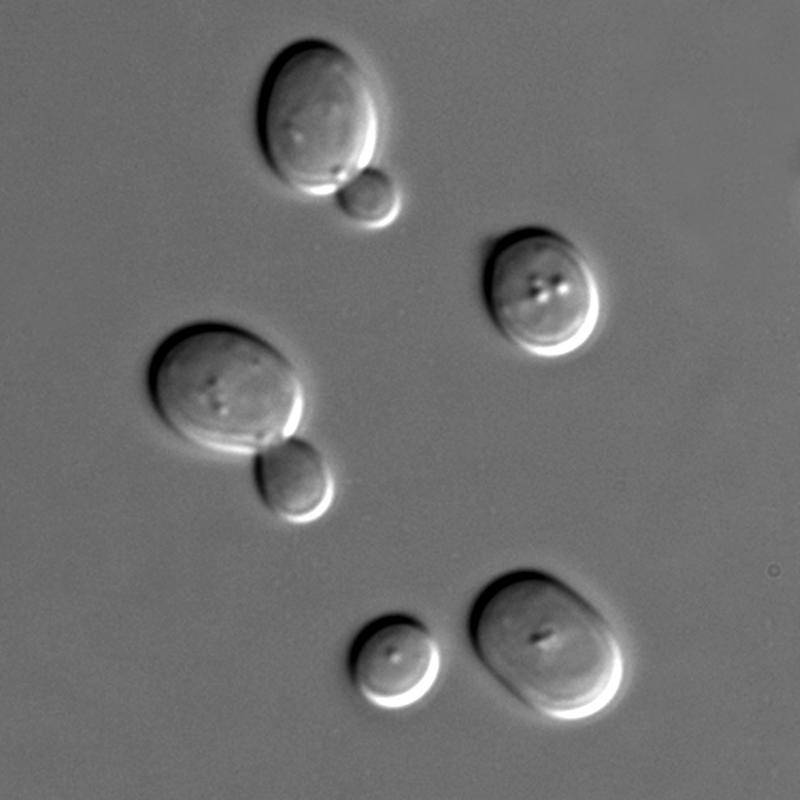A few weeks back, blog-reader Anson Kennedy sent me an idea for a Well Said/Say What? The article in question, “Evolution’s Random Paths Lead To One Place,” describes the work of Dr. Michael Desai at Harvard University to perform large-scale evolution experiments on baker’s yeast. I re-read it today, and realized it would make a great companion to my Misconception Monday post on randomness (or lack thereof) in evolution. I admit that it took a few passes to figure out whether it’s a Well Said! or a Say What? While clearly written and generally sound, a few unfortunate turns of phrase and a tendency to overstate the conclusions landed this as a Say What? Oh well, we’ve had a good run of Well Saids! lately. It had to end sometime.
Here is how reporter Emily Singer describes the research of the Desai lab: “Desai’s  plan was to track [640] yeast strains as they grew under identical conditions and then compare their final fitness levels, which were determined by how quickly they grew in comparison to their original ancestral strain. The team employed specially designed robot arms to transfer yeast colonies to a new home every 12 hours. The colonies that had grown the most in that period advanced to the next round, and the process repeated for 500 generations.”
plan was to track [640] yeast strains as they grew under identical conditions and then compare their final fitness levels, which were determined by how quickly they grew in comparison to their original ancestral strain. The team employed specially designed robot arms to transfer yeast colonies to a new home every 12 hours. The colonies that had grown the most in that period advanced to the next round, and the process repeated for 500 generations.”
Got that? Start with 640 different strains of yeast. Put them in identical lab conditions and every 12 hours, pull out the fastest dividing individuals to continue on. The researchers found that each of the colonies ended up with comparable relative fitnesses, results that seem to be suggest that no matter the genetic starting point, all of the labs’ yeast end up in the same place. Singer puts it like this, “According to results published in Science in June, all of Desai’s yeast varieties arrived at roughly the same evolutionary endpoint (as measured by their ability to grow under specific lab conditions) regardless of which precise genetic path each strain took.”
So, to unpack this a bit, each strain of the yeast had a different set of random mutations, but after 500 generations, they all reproduced at roughly the same rate in the lab. Singer suggests that this result challenges Gould’s famous idea that if you rewound the tape of life, you’d get something different. Instead, she says, “It’s as if 100 New York City taxis agreed to take separate highways in a race to the Pacific Ocean, and 50 hours later they all converged at the Santa Monica pier.”
It was this quote that Mr. Kennedy was nominating for a “say what?” treatment, and I think he has a good point. In his email to me, Kennedy wrote, “The author's analogy assumes evolution has a defined endpoint it is moving towards. It’s not as if 100 NY taxis agreed on a common endpoint and then somehow managed to get there totally independently. It would be more like 100 taxis took off in 100 different directions and then, 50 hours later, all converged on the same location (I think).”
 I agree! And well-caught, Mr. Kennedy! The author’s analogy has an unfortunate element of pre-determination. And in my opinion, this sets the report off in a bad direction. Singer insists on overblowing the actual results of the experiment, which was essentially that in a controlled environment under defined selective pressure, organisms will arrive at a similar level of improved fitness, but there seems to be a limit on how much they can improve on that one characteristic. The strains that already grew relatively fast will change more slowly than those that were slowest. In other words, there are apparently some constraints on how fast yeast can grow, but if that's what you're selecting for, different clones will exploit a lot of different paths to reach a similar limit. After wading through the original paper with me, NCSE Director Ann Reid offered this more targeted analogy: It’s as if 100 engineers tinkered with 100 similar cars to get them to go faster. The engineers would probably find lots of different ways to do it, and the cars that were already faster wouldn't improve as much, but they would probably all end up going about the same speed.
I agree! And well-caught, Mr. Kennedy! The author’s analogy has an unfortunate element of pre-determination. And in my opinion, this sets the report off in a bad direction. Singer insists on overblowing the actual results of the experiment, which was essentially that in a controlled environment under defined selective pressure, organisms will arrive at a similar level of improved fitness, but there seems to be a limit on how much they can improve on that one characteristic. The strains that already grew relatively fast will change more slowly than those that were slowest. In other words, there are apparently some constraints on how fast yeast can grow, but if that's what you're selecting for, different clones will exploit a lot of different paths to reach a similar limit. After wading through the original paper with me, NCSE Director Ann Reid offered this more targeted analogy: It’s as if 100 engineers tinkered with 100 similar cars to get them to go faster. The engineers would probably find lots of different ways to do it, and the cars that were already faster wouldn't improve as much, but they would probably all end up going about the same speed.
In another “say what?”-worthy quibble, Singer writes, “Genetic mutations occur mostly at random, yet the sum of these aimless changes somehow creates a predictable pattern.” Somehow? It’s called natural selection. Or, in the case of this lab result, artificial selection since only the yeast with the fastest reproductive rates were selected by automated robots every 12 hours to continue the colony.
And, while we’re taking about natural selection, let’s discuss the elephant in the room (the yeast in the Petri dish?): the conditions for the experiment were controlled and the definition of evolution was limited to fitness. In this way, one of the random components of evolution, environmental conditions, was eliminated. Is it so surprising that there were similar levels of fitness achieved among the colonies of yeast kept in identical, controlled conditions? And yeast most commonly reproduce asexually by budding or binary fission, so again, a lot of randomness associated with genetic shuffling in meiosis and sexual reproduction was eliminated. These are pretty sterile conditions!
When Gould talked about rewinding the tape of life, he wasn’t talking about doing it under controlled laboratory conditions—he was talking about doing it in the real, messy, multivariable, world. Singer does acknowledge this by writing near the end of her piece, “It’s also not yet clear whether Desai’s carefully controlled results are applicable to more complex organisms or to the chaotic real world, where both the organism and its environment are constantly changing.” Right. So wouldn’t it be better to limit inflated statements that make it seem like the path of evolution is somehow fixed, and instead talk about what this important research really does clearly demonstrate—that there are countless paths that achieve the same goal of survival and reproduction. That is a cool conclusion! These researches have shown in an unprecedented large-scale controlled experiment that DNA isn’t destiny, and that “life will find a way.” (Quick! Name that movie! Bonus points for context and character.)
Have an idea for a future Misconception Monday or any other kind of post? See some good or bad examples of science communication lately? Drop me an email or shoot me a tweet <at>keeps3.

